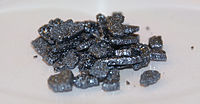
Photo from wikipedia
An unusual skeletal rearrangement of piperazine into ethylenediamine has been observed for the first time as a result of an attempt to synthesize a piperazine-linked metal-organic framework (MOF) using cage… Click to show full abstract
An unusual skeletal rearrangement of piperazine into ethylenediamine has been observed for the first time as a result of an attempt to synthesize a piperazine-linked metal-organic framework (MOF) using cage Cu(II),Na-phenylsilsequixane as a potential building block. Instead of the expected "metallasilsesquioxane-based MOF", a Cu6 complex 1 coordinated both by silsesquioxane and ethylenediamine ligands was isolated. An effort to reproduce this result via direct interaction of Cu-phenylsilsequioxane and ethylenediamine surprisingly afforded two other types of complexes, copper-sodium 2 and copper 3 ionic products. Cationic components in both products 2 and 3 are represented by (i) copper and sodium ions (in the case of 2) or (ii) copper ions exclusively (in the case of 3) coordinated by ethylenediamine ligands. Both complexes 2 and 3 include Si6-based condensed silsesquioxane fragments serving as anionic components of the products. Symptomatically, the types of the Si6-frameworks in 2 and 3 are drastically different. More specifically, the Si6 unit in 2 is an unprecedented distorted silsesquioxane skeleton consisting of two condensed tetramembered rings. Structural features of compounds 1-3 were established by single crystal X-ray diffraction. Compound 2 was found to catalyze the oxidation of cyclohexane to cyclohexanol and cyclohexanone with H2O2 (a mixture of these products was obtained after adding PPh3 to the reaction solution) as well as the transformation of cyclohexanol to cyclohexanone under the action of tert-butyl hydroperoxide.
Journal Title: Inorganic chemistry
Year Published: 2020
Link to full text (if available)
Share on Social Media: Sign Up to like & get
recommendations!